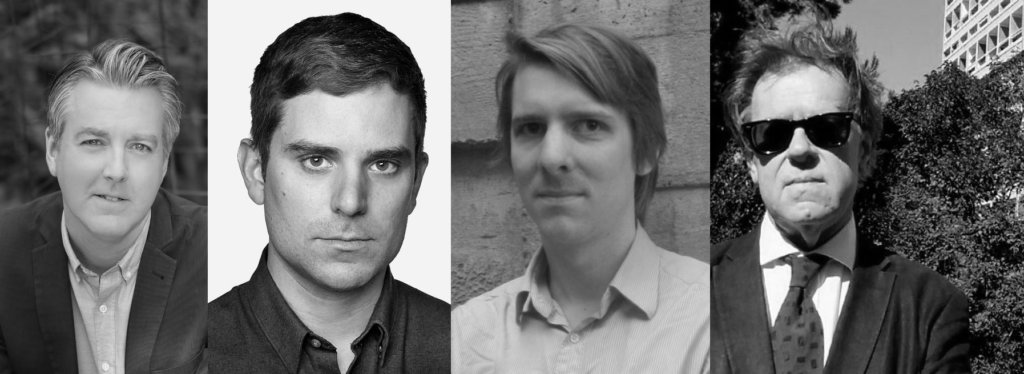
I’m listening again to selections from the archive of long-form interviews I conducted on the public radio program The Marketplace of Ideas and podcast Notebook on Cities and Culture between 2007 and 2015.
In trying to understand a place, I begin with its architecture. This puts rural environments at a disadvantage against urban ones, granted, but as you may have guessed I spend most of my time in cities anyway. That cities would become central to my personal and professional worldview seemed a vague possibility when I began the public radio show The Marketplace of Ideas in Santa Barbara in 2007, and had become an obvious fact by the time I moved to Los Angeles and turned it into the podcast Notebook on Cities and Culture in 2012. Somehow I never did any architecture-centric interviews on the former, but I wasted no time doing them on the latter.
The first Los Angeles interviewee to come to mind was the architecture critic who had helped familiarize me with the city even before I got there: the Los Angeles Times‘ Christopher Hawthorne. His yearlong “Reading L.A.” project coincided with the final months of my preparation to move and my first few months in Los Angeles, and the following year I was able to read his series on the boulevards while getting to know those boulevards first-hand. In between came our interview, recorded in the back garden of Frank Gehry’s Walt Disney Concert Hall, just one of the hidden-in-plain-sight aspects of Los Angeles — the garden, not the hall itself, which couldn’t be less hidden in plain sight — of which he and his work have made me aware.
Not long after I took Notebook on Cities and Culture worldwide, a listener recommended I record a season in Toronto, a city to which I admit I’d never given much thought. (This had less to do with its being Canadian than its being on the eastern half of the North American continent; I’d been making occasional trips to Vancouver since childhood.) Naturally, I first looked up Toronto’s most prominent architecture critic, the Globe and Mail‘s Alex Bozikovic. Through talking with him and other experiences there, I came to realize how much Toronto and Los Angeles have in common, less on their surfaces than in their depths: long stretches of obsession over attaining “world-class” status, for example, or reputations as “ugly” that few particular vistas justify and a modern identities built on the sheer variety of its population’s foreign origins.
The more cities I visited, the more instinctively I looked for architecture critics to interview in them. This naturally made a conversation with Owen Hatherley as essential in London as the brown sauce on the English breakfasts we ate while recording. It was equally essential, in a different way, that I book a flight from London to Marseilles to interview Jonathan Meades — not, strictly speaking, an architecture critic, but something closer to a generalist critic who happens to write a great deal about buildings and the build environment. (He also happens to live in Le Corbusier’s Unité d’habitation, which I certainly wasn’t going to miss chance to enter, let alone record an interview inside.)
At the time of our interview, Meades had just finished production on his documentary Bunkers, Brutalism and Bloodymindedness: Concrete Poetry, at the end of which he delivers one of my favorite architectural statements of all time:
The destruction of Brutalist buildings is more than the destruction of a particular mode of architecture. It is like burning books. It’s a form of censorship of the past, a discomfiting past, by the present. It’s the revenge of a mediocre age on an age of epic grandeur. It’s the cutting down to size of a culture which committed the cardinal sin of getting above its station, of pushing God aside and challenging nature. It’s the destruction, too, of the embarrassing evidence of a determined optimism that made us more potent than we have become. We don’t measure up against those who took risks, who flew and plunged to find new ways of doing things, who were not scared to experiment, who lived lives of perpetual inquiry. Here was mankind at its mightiest. Brutalism has to go. For it is the built evidence of the fact that once upon a time, we were not scared to address the Earth in the knowledge that the Earth would not respond, could not respond.
In the years since these interviews I have, of course, moved to Seoul, but just last month Christopher Hawthorne made his first visit here in his current capacity as the City of Los Angeles’ Chief Design Officer. A couple years ago, Owen Hatherley came to write up one of my own top hangouts, Sewoon Sangga. And having spent more time in Toronto this past year, I’ve made sure to catch up with Alex Bozikovic and have him fill me in on what has gone on there, architecturally and otherwise, over the past half-decade. (I’m happy to report that Robarts Library still stands in all its Brutalist glory.) And as for Jonathan Meades, well, what I wouldn’t give to read his take on Asia. Is there a publication we can convince to send him out here?
- Download Christopher Hawthorne on Notebook on Cities and Culture [iTunes link] (7/19/12)
- Download Alex Bozikovic on Notebook on Cities and Culture [iTunes link] (10/29/14)
- Download Owen Hatherley on Notebook on Cities and Culture [iTunes link] (4/6/14)
- Download Jonathan Meades on Notebook on Cities and Culture [iTunes link] (3/7/14)